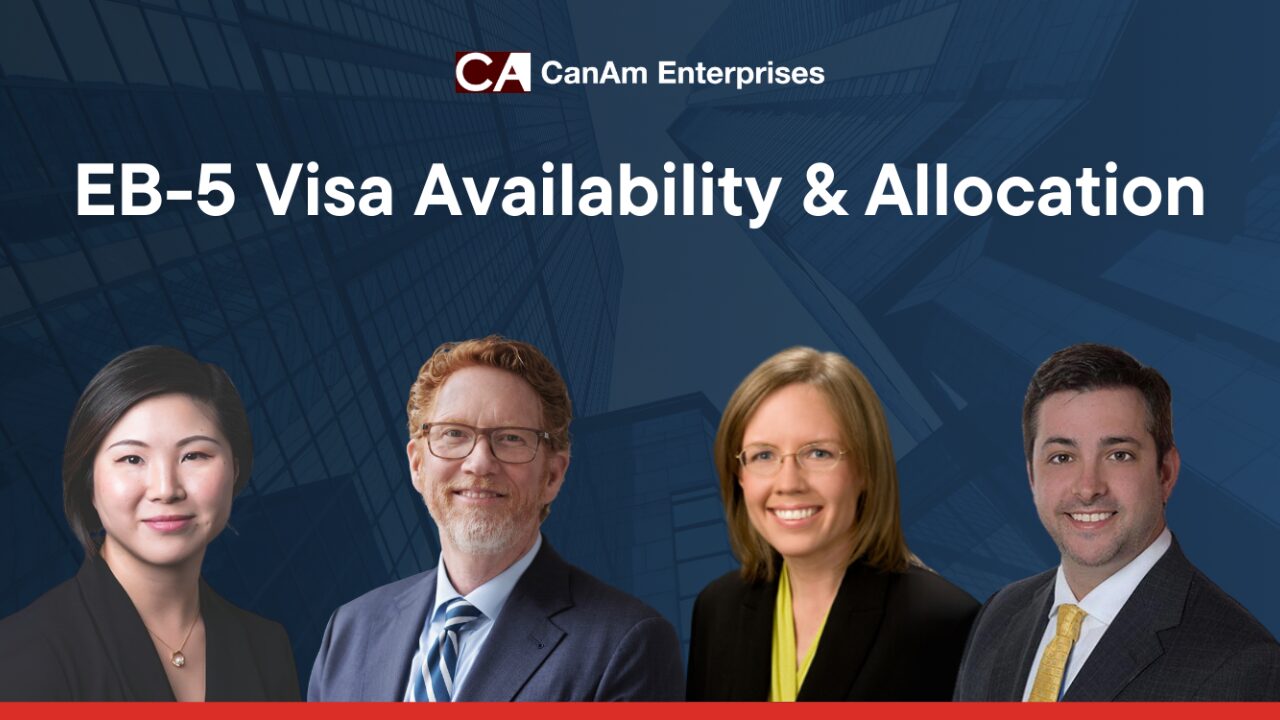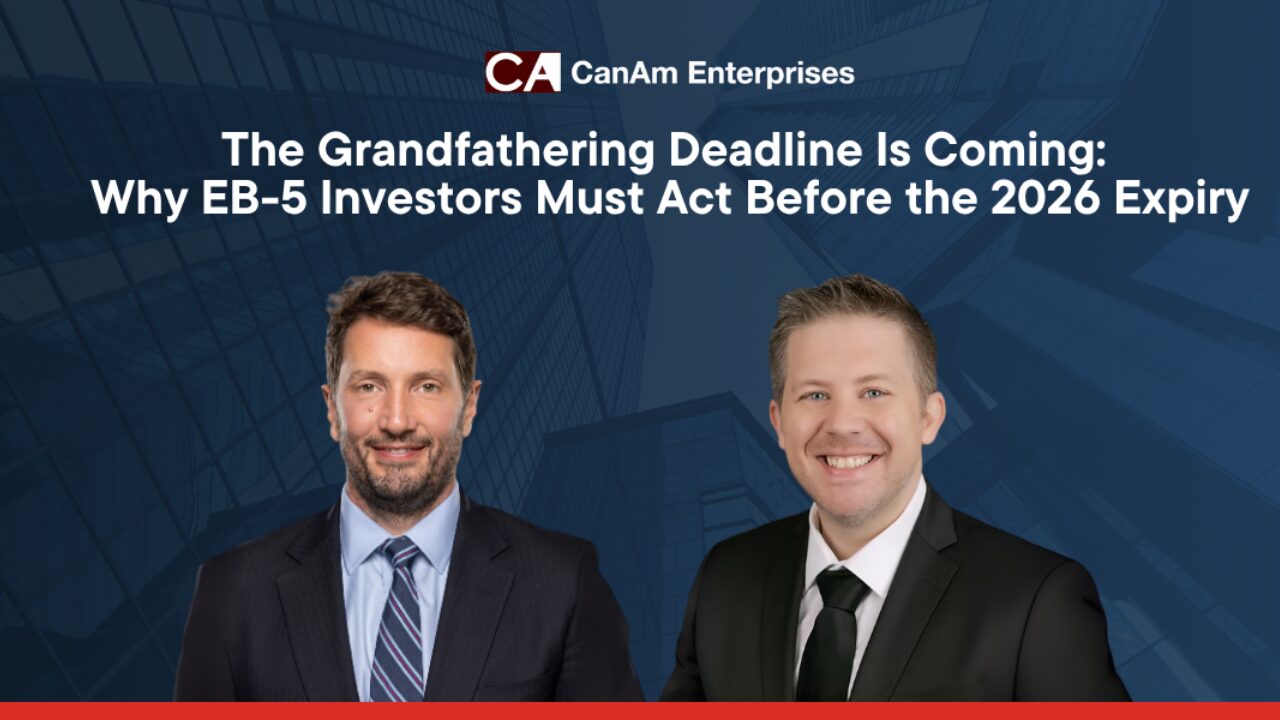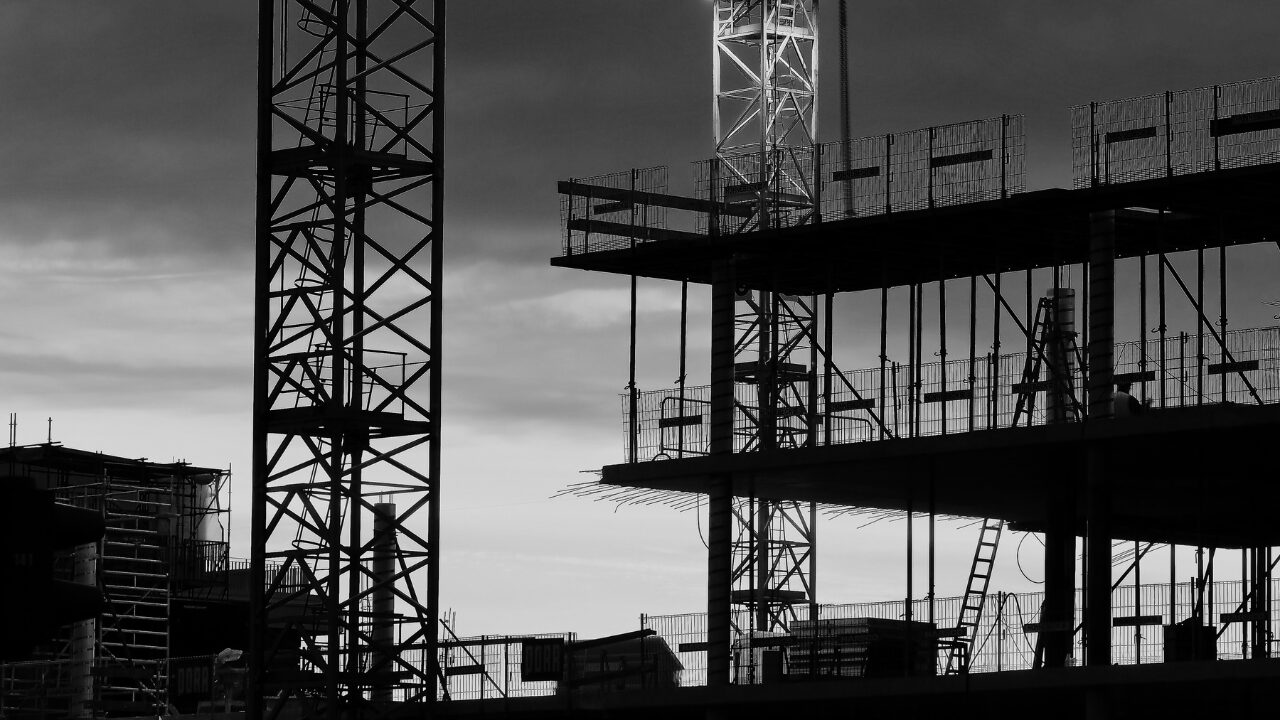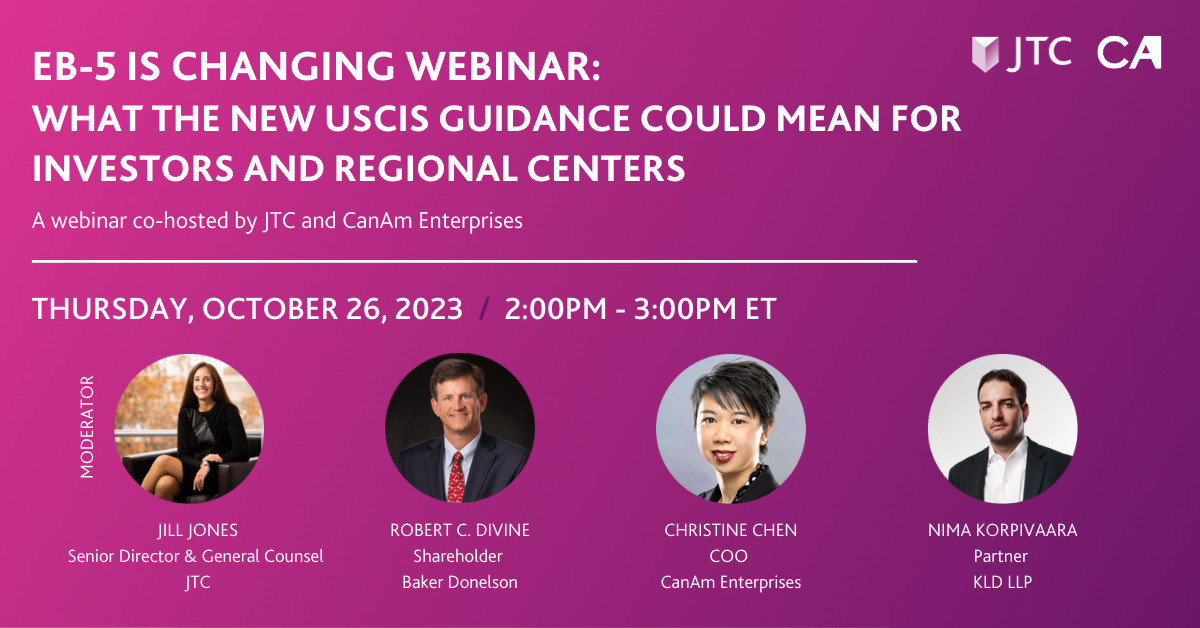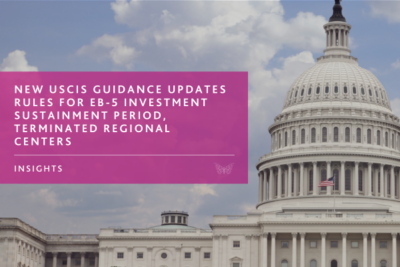The EB-5 Immigrant Investor Program remains one of the most effective ways for global investors to achieve U.S. permanent residency. But in 2025, the EB-5 landscape has grown more complex than ever—surging demand, visa backlogs, and upcoming policy deadlines are creating new challenges for families considering this path.
To help investors make sense of it all, CanAm Enterprises recently hosted a webinar featuring three of the industry’s most trusted voices:
- Suzanne Lazicki – EB-5 Analyst and Author of LucidText
- Joey Barnett – Partner, WR Immigration
- Nicolai Hinrichsen – Partner, Miller Mayer LLP
Together, they addressed today’s most pressing EB-5 questions, from retrogression risks to concurrent filing benefits. Their insights also complement the newly released white paper commissioned by CanAm, Visa Availability and Allocation: Q&A for 2025, authored by Suzanne Lazicki.
Investors can download the full white paper here.
Understanding the EB-5 Visa Backlog
Backlogs happen when the number of EB-5 applicants exceeds the annual 10,000 visa allocation. With more than 60,000 investors already in the pipeline, the backlog is not only real—it’s unavoidable.
“The most important thing to know is that there are a lot of people in process to get an EB-5 visa, and when there are a lot of people in process and a limited number of visas, somebody is going to be waiting.” – Suzanne Lazicki
The critical question is not if there will be delays, but who will wait—and for how long.
Visible vs. Invisible Backlogs
The Visa Bulletin only reflects investors who have cleared I-526 adjudication. But as Lazicki explained, thousands more remain stuck in the I-526 queue, creating an invisible backlog. This means official wait times often understate the reality.
EB-5 Country Caps: Why Nationality Matters
Because of the 7% per-country visa cap, investors’ wait times differ sharply by nationality.
- China & India – Facing inevitable retrogression and multi-year delays
- Rest of World (ROW) – May avoid retrogression, especially by leveraging flexibility between reserved and unreserved categories
“If you’re from China or India, retrogression coming up against a Visa Bulletin cutoff date is inevitable.” – Suzanne Lazicki
Concurrent EB-5 Filing: A Game-Changer
The EB-5 Reform and Integrity Act (RIA) of 2022 introduced concurrent filing, allowing U.S.-based investors to file their I-526E petition and I-485 adjustment of status simultaneously, provided a visa is available.
This unlocks immediate benefits:
- Work authorization (EAD)
- Travel authorization (Advance Parole)
- Lawful presence while awaiting adjudication
“Concurrent EB-5 filing is a huge benefit. It allows you to file for work and travel authorization immediately while your green card petition is pending.” – Joey Barnett
For students nearing OPT expiration or H-1B professionals stuck in EB-2/EB-3 backlogs, this option provides a critical safety net.
The 2026 EB-5 Grandfathering Deadline
A pivotal date looms: September 30, 2026. Any EB-5 investor who files before then is “grandfathered.”
“An investor who files their I-526 by September 30, 2026 is grandfathered. That means even if the EB-5 Regional Center Program is not reauthorized after 2027, those filings still get adjudicated under current law.” – Joey Barnett
This safeguard doesn’t accelerate visa issuance, but it protects eligibility amid legislative uncertainty.
Rural vs. High-Unemployment EB-5 Projects
Investors often ask whether a rural project or a high-unemployment project is the better choice.
- Rural Projects – Receive priority processing and more visa set-asides
- High-Unemployment Projects – May offer stronger financial feasibility
“There’s a psychological benefit to actually having the I-526 be approved, as it certainly will be in a rural category. That certainty can be very important.” – Nicolai Hinrichsen
The right choice depends on each investor’s timeline and family priorities.
Switching EB-5 Categories: What’s Possible?
Investors sometimes wonder if they can change categories after filing.
- At NVC stage – Yes, applicants can switch between eligible categories
- For U.S.-based adjustment – No current USCIS mechanism exists
“Switching categories is possible at the NVC stage, but USCIS has yet to come out with a mechanism for switching in adjustment cases.” – Nicolai Hinrichsen
Retrogression: A Risk and a Motivator
Retrogression doesn’t just delay green cards—it often motivates action.
“I’ve never had a client tell me they wish they would have waited longer to file EB-5. Time matters. I’ve seen many kids age out by a day.” – Nicolai Hinrichsen
Barnett agreed, noting retrogression is a “huge motivator,” particularly for families relying on EB-5 as a backup to H-1B sponsorships.
Transparency and Managing Investor Expectations
The experts emphasized transparency in investor communications.
“If people invest thinking they’ll get a green card in three years and it actually takes eight, that can be a personal disaster. We want investors to make informed decisions.” – Suzanne Lazicki
Barnett added:
“There’s a lot of chatter online: ‘I got my green card in eight months.’ That is not reality for someone filing today.”
Key Takeaways for EB-5 Investors in 2025
- Visa backlogs are inevitable—but timelines differ by country and category
- Chinese and Indian nationals face the longest waits
- Concurrent EB-5 filing offers immediate benefits to U.S.-based investors
- The 2026 grandfathering deadline is critical—file before it expires
- Choosing between rural and high-unemployment projects requires careful strategy
- Transparency and realistic expectations are key
Download the Full White Paper
For a deeper dive into EB-5 visa allocation, backlogs, and investor strategies, CanAm commissioned Suzanne Lazicki to author a comprehensive white paper:
📄 Download the White Paper: Visa Availability and Allocation – Q&A for 2025
This resource expands on the webinar discussion, providing detailed data and guidance to help investors and advisors navigate the evolving EB-5 landscape with clarity.
Conclusion: EB-5 as a Long-Term Immigration Strategy
Despite growing wait times, EB-5 continues to be one of the strongest immigration pathways for global investors. It combines long-term residency benefits with immediate advantages such as concurrent filing.
As CanAm’s Min Wu summarized:
“It’s very important for industry experts to provide transparency and guidance so investors can make clear decisions along the way.”
For investors considering EB-5, the message is clear: the time to act is now. Filing strategically—and before the 2026 grandfathering deadline—can preserve opportunities for families seeking a future in the U.S.


